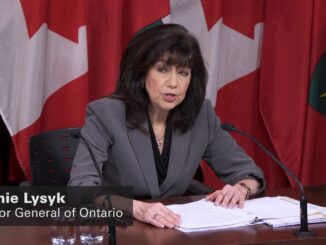
In August, I woke up to a nightmare – severe neck pain that left me feeling partially paralyzed. Little did I know this was the beginning of a frustrating journey through Ontario’s healthcare system.

My name is Jamila Apolinario, a 27-year-old journalism student. I will tell you the story of the challenges I faced in navigating Ontario’s healthcare system. From a painful emergency room (ER) wait to a frustrating quest for an MRI, my story reflects the struggles many face. This short documentary is a snapshot of Ontario’s healthcare crisis, shedding light on staffing issues, long wait times, and the need for change.
My ER Dilemma
I was rushed to North York General Hospital, where I faced an agonizing wait in the emergency room. I endured an extended wait until someone finally told me that I could proceed to the green room. However, I waited for an additional 30 minutes while observing the doctor pacing back and forth. It wasn’t until the nurse approached me and insisted I wear a hospital gown that I finally got to see the doctor.

I did not realize that it was requirement. Surprisingly, this crucial information had not been communicated to me upon my arrival in the green room. Fortunately, the same nurse assisted me in changing considering the intensity of my pain that left me unable to move.
Finally, the ER doctor came, and his initial response was a prescription for Tylenol extra strength, leaving me bewildered. When I questioned the prescription, the doctor gave me a morphine prescription. The doctor told me that I will get a call from the MRI department for my scheduled appointment.
“We’re doing everything. We’re doing the work of a personal support worker, of a secretary. We do everything, honestly, on the floor, and it is just so, so tiring. It’s not just physically tiring. It’s mentally exhausting. It’s emotionally exhausting,” Registered Nurse Nikka Bajar said
Bajar, formerly worked in North York General Hospital, describes the understaffing crisis in hospitals. She

says that during her night shifts, she found herself caring for 12 patients with only one nurse and a single Personal Support Worker (PSW). Despite recognizing potential risks and feeling as though situation was unsafe, the shortage of available nurses left Bajar with limited options for improvement. The issue of understaffing appears to extend beyond her experience, indicating a widespread crisis with no easy solutions.
Peter Weltman the former Financial Accountability Officer of Ontario says, “staffing shortages cause long emergency room wait times and closures. Without additional measures, challenges in the health sectors will continue.”
A 2023 report from the Financial Accountability Office of Ontario(FAO) found the provinces shortage of nurses and PSWs will persists, projected to reach 33,000 by 2027-28 despite government efforts. It found these shortages undermine current programs and hinder meeting healthcare expansion commitments, affecting hospital discharges, emergency department operations, and aging population’s demands, exacerbated by insufficient funding and inadequate measures to supply needed healthcare personnel.
Bajar says the issue is multilayered. When Bajar was asked about what she thinks the government should do, Bajar suggested a few other potential solutions, such as making it easier for international workers to get their nursing license, hiring more nurses, tuition fee reimbursement, and better benefits.
The same report from the FAO shows the government plans on spending almost 41-million dollars on health care from 2022 to 2032. That’s almost 4-million dollars more than the government planned to spend in 2012.
Actual and Planned Investment in Health Infrastructure (source Financial Accountability Office of Ontario)
Mike Schreiner, Ontario Greens leader, strongly criticizes Doug Ford government for allowing over 1,000 healthcare services closures in 2023 Screiner calls it unacceptable and shameful, urging the government to stop healthcare privatization, treat frontline workers fairly, and increasing funding. The statement emphasizes the need for a government that values public healthcare, highlighting the urgency in addressing staffing and capacity crises by investing more healthcare workers and services.
My MRI Ordeal

I tried reaching out to the MRI department, but my relentless calls reached a dead end. Finally, my partner stepped in, demanding answers. He also went through the series of calls and finally got ahold of the MRI department. He then asked them for the earliest appointment. However, the MRI appointment was set for a month away, highlighting the strain on diagnostic services.
I am fortunate to see my family doctor quickly, but not everyone is so lucky.
According to Statistics Canada’s 2022 report, nearly 35% of Ontarians experienced waits of more than three days to see their family doctor. Nova Scotia has it worse, where a staggering 68% of residents faces similar delays in accessing primary healthcare. This emphasizes the discrepancy in accessibility to healthcare.
Percentage of Family Doctor wait times in every Province of Canada (source Statistics Canada)
After the MRI, I expected my family doctor to receive the results promptly. However, I faced another hurdle - a discrepancy in communication.
Taking the advice of the emergency doctor, I tried reaching out to the emergency room for my MRI results. And to my surprise, I was informed that the information wasn't available there, and I was directed to consult my family doctor for the findings.
Baffled, I made an appointment to visit my family doctor. The doctor told me that the ER doctor noted on my file that I should return to the ER for the results. This initiated a frustrating sequence of calls, transfers, and confusion. The family doctor, in an attempt to bridge the gap, wrote a formal letter insisting on the results. It was only with the assistance of my family doctor that I eventually manage to navigate the complexities and obtain the results I sought.
Data from the FAO indicates that there is a significant increase in ER visits. This figure exceeds the number of ER visits recorded during the pandemic by 5,000 visits. The pandemic had previously led to a one year decrease in ER numbers, but the current data suggests a return to regular visitation patterns. This upward trend indicates a potential shift towards pre-pandemic levels of healthcare utilization in the province.
Results and Diagnosis

Finally October came, the results had arrived, revealing a protrusion in my neck that could lead to surgery if not treated promptly. The family doctor managed to secure a neurology appointment for December. Again, this underscores the prolonged waiting times for specialized care.
From long ER waits to a frustrating MRI quest, my story reflects broader systematic challenges in Ontario's healthcare system. It forces us to address root causes to the problems, and create reforms that prioritize accessibility and efficiency. The road ahead may be tough, but by amplifying these issues, we pave the way for informed discussions, policy changes, and a collective efforts to build a healthcare system that serves all Ontarians.
As I conclude this article, I am still in pain, eagerly waiting for my neurology appointment.




Be the first to comment